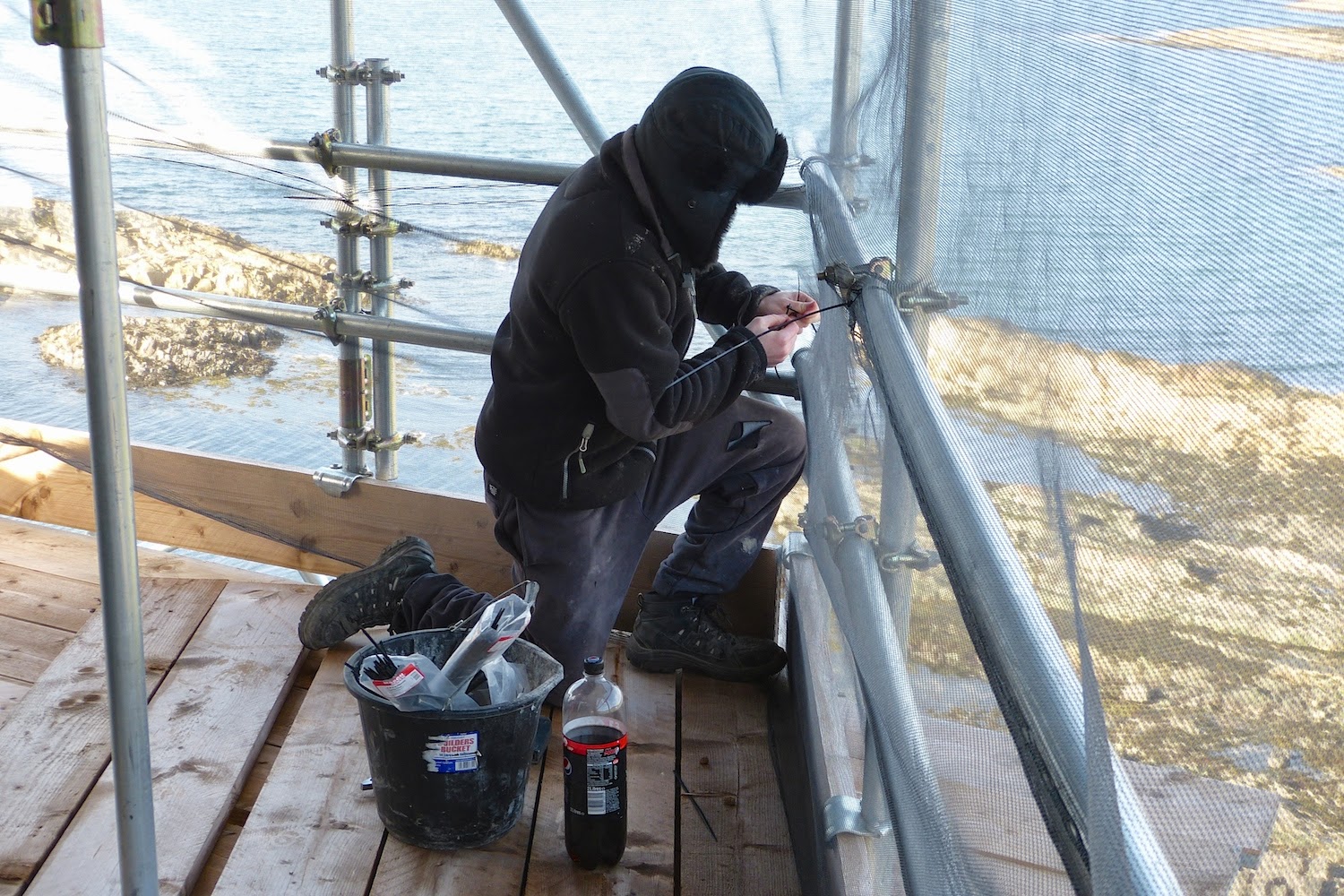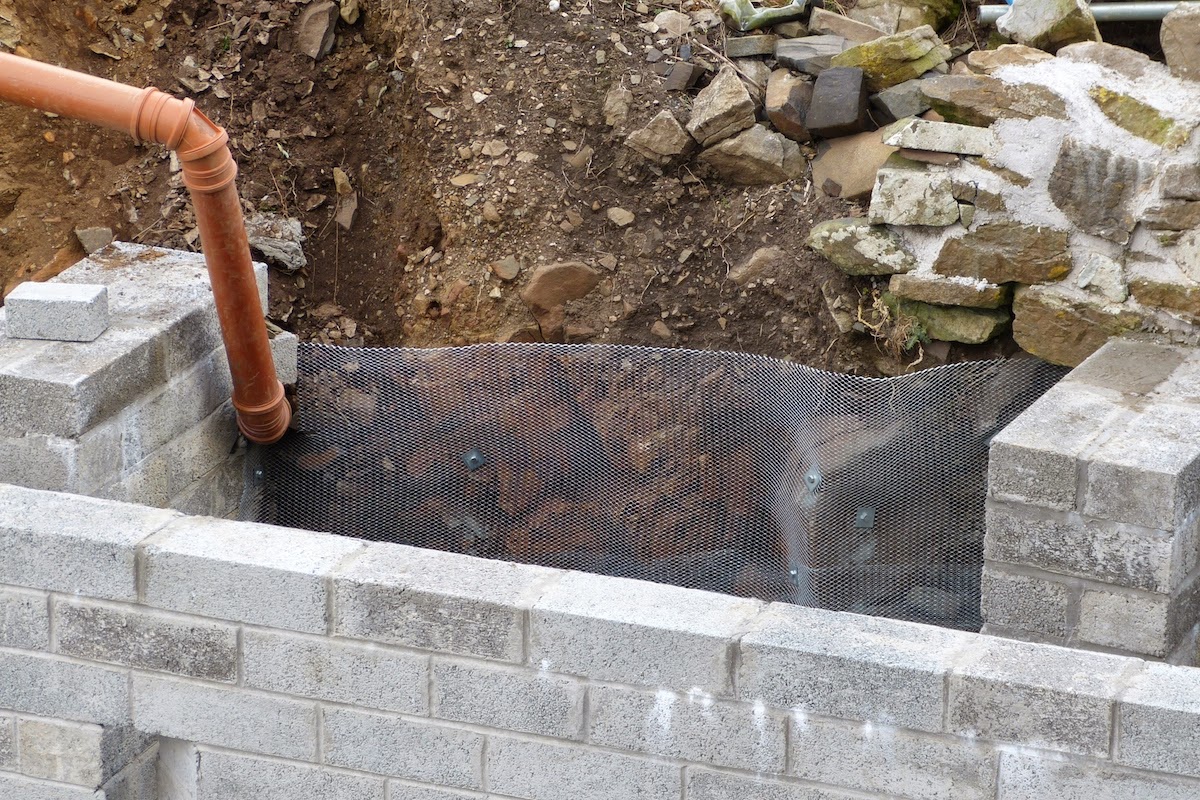The weather has made a dramatic change in the last ten days, from the very wet winter which made progress on the castle so difficult to what seems like summer, with spring missed out. In the cliffs to the east of the castle, the sea pinks are in full bloom. The red behind them....
....is the jacket of one of the five men who are now working on the east curtain wall of the castle, doing the first stage of the pointing there having completed the process on the north wall.
It's painstaking work as the mortar has to be pushed deep into the crack between each stone. Picture shows, from right to left, Richard, Paul, Bradley, Matthew and Adam.
They're all Yorkshire lads with typical Yorkshire senses of humour, which must make what might otherwise be a tedious job more fun. Bradley complained I hadn't taken a photo of him, so here it is.
But the process of repairing the walls has now moved beyond pointing. Damien Summerscales is a stonemason - also from Yorkshire - who has begun repair work on the more severely damaged parts of the walls, where the wall effectively has to be rebuilt. He's just completed a repair here, measuring about 1.5m x 0.5m, using stones that have been cleaned ready for the job. One wonders what caused the damage - a cannon ball from one of Mingary's sieges?
The Mingary Castle restoration blog was written by Jon Haylett, who lives in the local village of Kilchoan. Now that restoration is almost complete Holly and Chris Bull will take over to report on bringing the Castle back to life.
Thursday, 24 April 2014
Thursday, 17 April 2014
Daffodils
The evidence that tells us the history of a place like Mingary Castle usually comes from records such as writings and maps, and from the sort of intense archaeological investigations that have taken place here. But sometimes evidence pops up from unexpected quarters.
The daffodils were in bloom this morning, but not at their best in a brisk westerly which brought showers across the Sound of Mull. That they stop so suddenly against the hardcore that forms the car park in front of the castle is a reminder that they used to run right across the area in front of the castle, and used to be a wonderful sight at this time of year.
They were planted in 1971 or 72 by the then owner of the Estate and the castle, Mike Thompson, who was a member of the family who owned Thompson Newspapers. The bulbs came from a horticultural business he owned down in Angus, and were planted for show - though bulbs were planted for commercial reasons elsewhere, such as on Coll. The Thompsons owned the castle from 1968 to 1973.
When the car park was built the bulbs under it weren't lost. Many were dug up and planted elsewhere on the Estate.
The daffodils were in bloom this morning, but not at their best in a brisk westerly which brought showers across the Sound of Mull. That they stop so suddenly against the hardcore that forms the car park in front of the castle is a reminder that they used to run right across the area in front of the castle, and used to be a wonderful sight at this time of year.
They were planted in 1971 or 72 by the then owner of the Estate and the castle, Mike Thompson, who was a member of the family who owned Thompson Newspapers. The bulbs came from a horticultural business he owned down in Angus, and were planted for show - though bulbs were planted for commercial reasons elsewhere, such as on Coll. The Thompsons owned the castle from 1968 to 1973.
When the car park was built the bulbs under it weren't lost. Many were dug up and planted elsewhere on the Estate.
Many thanks to Sue & Dochie Cameron for information about the Thompsons.
Thursday, 10 April 2014
A Progress Report
After yesterday, when the wind went round into the southwest and brought us a day of driving rain, it was a joy to go down to the castle in this morning's bright sunshine to see how work was progressing. There's a lot going on, and every sign that things are gearing up for a big push through what are usually, from a weather point of view, the better months of the year, May and June.
The sharp-sighted amongst this blog's readers will have spotted another change to the castle's appearance....
....it's being clothed in netting.
With three stonemasons arriving next week, and more workmen thereafter, building work on the walls will proceed apace, and this is best done with some protection from the rain. The netting is what builders call 'dust and debris' netting, and it's not what would usually be used to keep a building weatherproof, but the normal material is thicker and more wind-resistant, and wouldn't survive in local conditions.
Scaffold subcontractor John Forsyth is fitting the netting. For him, yesterday, while not pleasant, gave him an opportunity to see whether this netting is effective in keeping the rain off the walls - and it is.
John was being assisted this morning by Paul Hickman, who can be seen using plastic ties to fix the netting to the scaffold poles. It's also stapled to the vertical scaffolding board which runs around the edge of each 'lift' (walkway).
John has also almost competed the scaffolding of the upper part of the biomass boiler house so it can now be built up until it's level with the car park.
Meanwhile, the lads are continuing with the long job of pointing the outside of the great curtain walls. Picture shows John O'Neil working on the east wall, with the heather-clad hill called Glas Bheinn in the distance behind him.
The sharp-sighted amongst this blog's readers will have spotted another change to the castle's appearance....
....it's being clothed in netting.
With three stonemasons arriving next week, and more workmen thereafter, building work on the walls will proceed apace, and this is best done with some protection from the rain. The netting is what builders call 'dust and debris' netting, and it's not what would usually be used to keep a building weatherproof, but the normal material is thicker and more wind-resistant, and wouldn't survive in local conditions.
Scaffold subcontractor John Forsyth is fitting the netting. For him, yesterday, while not pleasant, gave him an opportunity to see whether this netting is effective in keeping the rain off the walls - and it is.
John was being assisted this morning by Paul Hickman, who can be seen using plastic ties to fix the netting to the scaffold poles. It's also stapled to the vertical scaffolding board which runs around the edge of each 'lift' (walkway).
John has also almost competed the scaffolding of the upper part of the biomass boiler house so it can now be built up until it's level with the car park.
Meanwhile, the lads are continuing with the long job of pointing the outside of the great curtain walls. Picture shows John O'Neil working on the east wall, with the heather-clad hill called Glas Bheinn in the distance behind him.
Tuesday, 1 April 2014
All's Well, John!
It was good to see John Forsyth back on site this morning. John is the man who built the incredible scaffolding lattice around the castle - 'incredible' because, while it was magnificent enough when it went up, it's stayed up! This has been the worst winter in living memory, with more gales than anyone can remember and heavy seas pounding the base of the structure, yet the worst that has happened on the scaffolding is that a few of the boards moved.
John's here to check that all's well - it certainly is.
Meanwhile, down in the moat, there's progress on the biofuel boiler building. With the breeze block walls in place and the mortar having, in the warmer weather, now gone off, they've put on two layers of plaster and sealed the exterior with bituminous paint to keep it waterproof.
The rubbly face around the structure is being held back with wire mesh which, if you look closely, has been pinned back to the rock. A layer of Kingspan insulation will be placed against the wall, and the gap then backfilled with rubble. The wall that remains exposed in the moat will have a facing of local stone to match the castle walls.
Large amounts of builders' materials were arriving as I left and, at any moment, three more static caravans to house the workers who will be arriving. There's a feeling of anticipation on site, as if, with the winter and the bad weather finally behind us, the project is really going to get cracking.
John's here to check that all's well - it certainly is.
Meanwhile, down in the moat, there's progress on the biofuel boiler building. With the breeze block walls in place and the mortar having, in the warmer weather, now gone off, they've put on two layers of plaster and sealed the exterior with bituminous paint to keep it waterproof.
The rubbly face around the structure is being held back with wire mesh which, if you look closely, has been pinned back to the rock. A layer of Kingspan insulation will be placed against the wall, and the gap then backfilled with rubble. The wall that remains exposed in the moat will have a facing of local stone to match the castle walls.
Large amounts of builders' materials were arriving as I left and, at any moment, three more static caravans to house the workers who will be arriving. There's a feeling of anticipation on site, as if, with the winter and the bad weather finally behind us, the project is really going to get cracking.
Subscribe to:
Posts (Atom)














